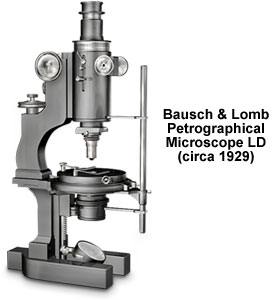Bausch & Lomb Petrographical Microscope LD
Based on the design of Dr. Fred E. Wright from the Carnegie Institution of Washington, D.C., the Bausch & Lomb petrographical microscope LD met most of the common requirements for petrography during the 1920s and 1930s. By utilizing polarized light, the LD, described in the 1929 Bausch & Lomb microscope catalog, aided in the measurement of the optical properties of rocks and minerals.

Characterized as a monocular, compound optical instrument, the most recognizable design innovation of the Bausch & Lomb petrographical microscope LD is the rigid bar that permits simultaneous rotation of the Nicol prisms by connecting to both the analyzer and polarizer. The polarizer, a 16-millimeter Ahrens prism, is set in a revolving mount, while the analyzer is a Glan-Thompson prism. For the Wright-style petrographical microscopes that predate infinity-corrected optics, fitting the analyzer with stigmatizing lenses helps compensate for changes in the optical path associated with the insertion or removal of the analyzer from the fixed-length body tube. As a side benefit, the analyzer prevents the shift of focus and removes astigmatism, which plagued the optical systems of many LD microscope predecessors.
The illumination system includes a convertible, aplanatic, three-lens condenser with a numerical aperture of 1.40 if fully assembled, and 0.40 numerical aperture when the upper two lenses are removed. The condenser rests in the fixed substage arm, below the condenser, and an iris diaphragm coupled to a 50-millimeter plano-concave mirror complete the lower end of the optical train. A rack and pinion mechanism permits adjustment of the substage and the selenite plates and polarizer it may contain.
The eyepieces for the Bausch & Lomb petrographical microscope LD feature cross hairs and magnifications ranging from 7.5x to 12.5x. A pinhole cap that fits a drawtube and a sliding stop ocular provide two options for observing the interference patterns of mineral grains. Interchangeable centering nosepieces are fitted with either two or three objectives. The range of magnification for the apochromatic objectives is from 4x to 45x. An internal Bertrand lens and a cap analyzer, employed in concert with the positive eyepieces, complete the optics for the polarized light microscope. Optical accessories include a bi-quartz wedge for measuring extinction angles, a one-quarter-wavelength plate, and a Wright combination wedge designed to fit into a common slot in each style of revolving nosepiece.
Coarse focusing is accomplished by a rack and pinion mechanism, which moves an inner tube in relation to the outer body tube, while fine focus is achieved with a modification of the Bausch & Lomb patented lever that features a graduated micrometer screw head. A revolving, circular stage with finely etched graduations facilitates the rotation of crystals and the observation of their optical properties. The extra large horseshoe-shaped base provides stability and vibration control to the precision optical instrument. A smooth black finish is accented by pewter graduated circles, and the instrument features nickel-plated adjusting heads.
BACK TO TWENTIETH CENTURY BAUSCH & LOMB MICROSCOPES
BACK TO TWENTIETH CENTURY MICROSCOPES
